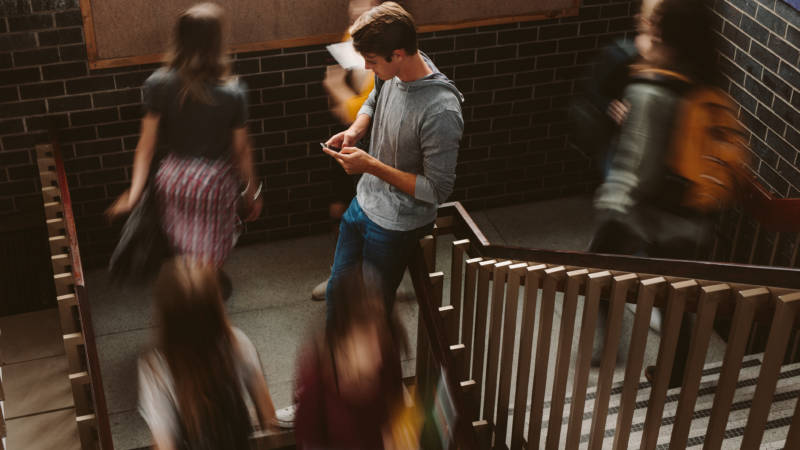“It was a different sound on campus; it sounded alive,” Gelb said. “There were students interacting with one another. There were students playing cards, engaged in rap battles, dance battles.”
Some students at San Mateo High understand why the Yondr pouches might be helpful to maintain focus during class, but are opposed to losing phone access during lunch and other breaks.
“Adults think it’s taking us away from the physical world, which is our human connection,” said sophomore Michiaki Sato. “I think the truth is that the technology is making us a new reality. We have a life on earth and we have a life on our phones.”
Arienne Adamcikova teaches Spanish at San Mateo High. She piloted the Yondr pouch in her classroom and recommended that the whole school adopt its usage after experiencing how it changed the dynamic. She says taking phones out of the equation improved her relationship with students.
“It was immediately beneficial,” Adamcikova said. “I no longer had to be this warden going around saying you need to turn that in either to my desk or the office.”
But students say they do homework on their phones and access digital assignments during lunch. And while they agree that they and their peers are on their phones a lot at lunch, they don’t see anything wrong with that, pointing out that sometimes they need a break from interacting with people.
“I feel like students should have the freedom to choose if they want to be on their phone or they don’t," said sophomore Clarissa Chen. “There are some people who don’t want to talk to people and they don't want to just sit there and not have anything to do.”
Students also talked about the anxiety they feel when they can’t check their phones. They know their friends are posting things and texting them and they’re worried they’ll be left out of the conversation. Their teachers understand that to a certain extent, but they’re hopeful that after a short adjustment period this new policy will lead to a better learning environment where students interact with one another more directly.
“I think culturally we’re all going through this connective need to constantly click and check social media and what’s going on online,” Adamcikova said. “I think that we’re trying to push back as a whole school and create a new culture. A culture where if everybody is in it together, then we’re all engaged together.”
Still, whenever adults ban something kids find a way around the rule. Just look at the iPad rollout in Los Angeles and how easily kids circumvented the pre-installed internet filters. San Mateo High kids admitted as much. They’re already scheming ways to get around the new system.
“The idea of having Yondr is supposed to have a connection between teachers and students,” Sato said, “but now that students are going to be sneaky, it’s actually going to open up a bigger gap between administration and students.”
He says some students are already planning to bring “dummy” phones to put in the Yondr pouches, and everyone already knows the magnet trick, a flaw that Yondr says it has fixed in their newest version. Some parents are also concerned that if students don’t have access to their phones during the day it will be difficult to contact them in an emergency. Assistant Principal Adam Gelb says the school is putting in place new procedures to train parents to call the office in an emergency, instead of directly contacting their child in class.
"I feel like we could do a lot better things with our funding," maintained sophomore Clarissa Chen. She feels the whole student body is being punished because a few kids don't have self control around phone use.


